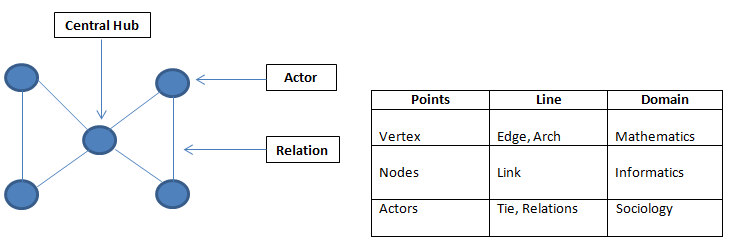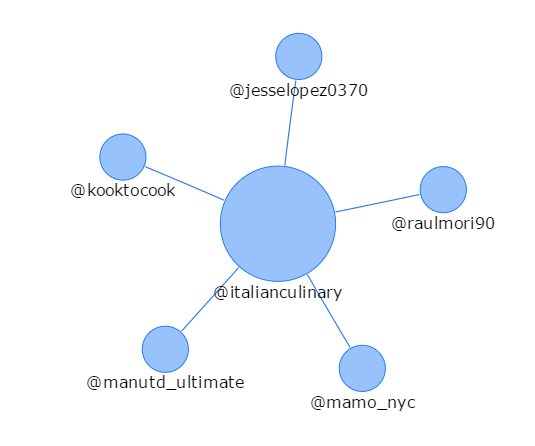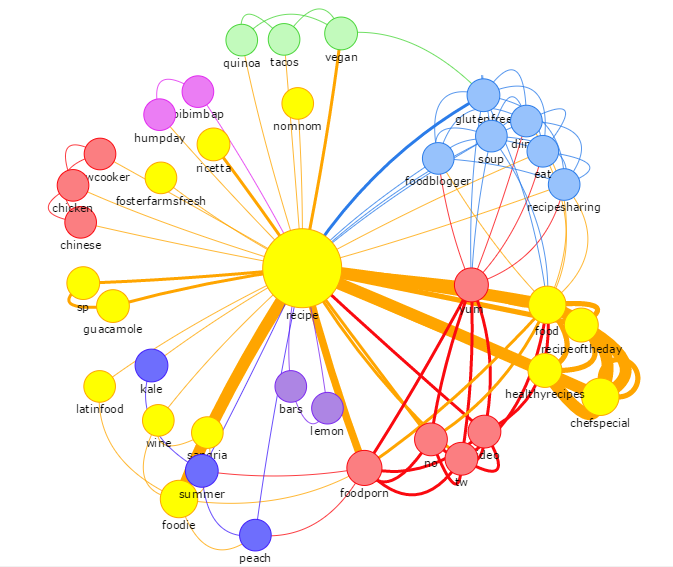Today the internet is accessible through multiple devices which enables the creation of real-time, solid relationships among users – and between users and brands. Despite the importance of this media in marketing strategies, few companies have a good understanding of conversation analysis or social network analysis and how they can be used to dramatically improve their marketing efforts and increase sales.
Users, Pages, Groups, and the interactions among them can be analysed using a wide range of qualitative/quantitative techniques. The objective of this series of posts is to explain what these networks are, how they work, and why interests and relationships mapping are useful for brands and digital marketers.
THE SOCIAL NETWORK
A social network can be visually depicted using a structure called a graph. A social graph is like a cloud composed of points that are connected by lines. The points are called “nodes” and represent the actors belonging to the network, while the lines are the relationships that tie differents nodes together.
In some networks, a node can be a link to all the others. This kind of node is called a “central hub.”

The relationships in a network are characterised by different attributes:
- Degree (Communication Frequency)
- Social Class (Best Friend)
- Type (Friend, Parent, Colleague)
Our purpose today is to briefly analyze each social network considering the peculiarities of their nodes and lines.
Facebook is structured on a simple model based on friendship that sounds like: “If you accept my friendship request, our tie will become mutual and symmetric”.
But this works only among “real person” nodes.
In fact, on Facebook the relationship between a user and a company is not symmetric. Companies must use a specific type of profile dedicated to them, the Fan Page. Fan Pages can’t send friend requests, they can only be followed by users and other pages. Therefore, in our graph, we will see that the Fan Page is the central node surrounded by:
- the connection among different Fan Pages
- the users who interact with Fan Pages
Fan Pages (and communities called Groups) are followed by users interested in a particular topic. These people specifically choose to be part of these networks. This means that the degree of the relationship is high – particularly at the moment of the subscription: in fact, it is very important for brands to maintain an high engagement with their users as the relationship is a vital touch point in their marketing strategy.
Add, Like, Comments and Shares are the main interactions. We will focus more on them in the next post.
Twitter is characterised by a simple system based on followers that sounds like: “I can follow and interact with you without asking permission”.
The social graph representation is direct, in fact the actors are in a symmetric relationship because they can share the same topic and interact with it without a friend request or linked request.
Private and corporate accounts have similar functionalities and there are no differences in terms of relationships (nodes, links, edges, ties, relations).
In the Twitter ecosystem networks are more “flexible”, thanks to the introduction of the hashtag in its dynamics: this means that, in addition to the traditional network where a profile is at the center and the followers are around it, each time a user looks for a specific hashtag, she will access a new fluid network where the hashtag becomes the central hub composed of new interactions.
The main interactions on Twitter are Follows, Mentions, Re-tweets, and Favorites. Stay tuned to learn more about them in the next post!
Instagram
If Twitter is based on a textual content dynamic, Instagram is instead a social network where pictures are the semantic object.
Content and Network Analysis of Instagram is similar to Twitter’s. Connections between Followers and Hashtags are direct, as well as the relationships among profiles. Also, Instagram user and company profiles have the same features.
However, Instagram’s network structure is more fluid than Twitter’s, as the central hub can be a specific profile, a hashtag and also a place (users can add this information to each picture). The ties are represented by interactions among users and the pictures.
User Graph Recipe Topic

This kind of analysis helps companies by giving them detailed descriptions of their relationships with customers on social networks. With this information, customer segmentation becomes an easy task!
Hashtag Graph #Recipe Topic

ROIALTY’s customer segmentation semantic engine is the right solution for brands and digital marketers, taking them beyond the analysis of relationships between the company and social users. It maps all of the interactions happening in the industry network and the interests and preferred ways of content consumption for each node, including interactions that are not linked to the company’s node. In this way, companies can spot loyal customers, customers who are likely to switch to competitors, influencers, potential leads, and can reach each of them with the correct call to action, at the right moment, on the best medium.

